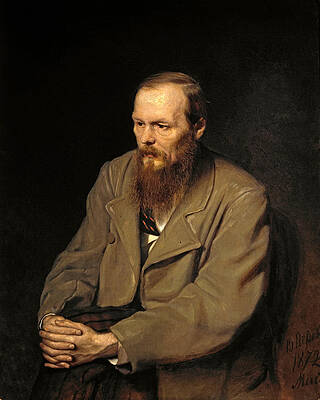Vasily Grigorevich Perov
Paintings
Fedor Dostoyevsky




Gogol is carried by the figures of his works to the grave







Reaper returning from the field in the province of Ryazan

Return of the peasants from a funeral in the winter

General, requiring horses. Sketch for the painting 'The scene at the post office'



Head of a Kirghiz. Study for 'The Court Pugachev'







Caretaker Letting an Apartment to a Lady




The girl, thrown into the water



Dividing the inheritance in a monastery (Death of a monk)

Children-Orphans on the Cemetery








Boy with raised hands, reaching out to the public






On the eve of bachelorette party. Seeing the bride out of the bath



Nikita Pustosvyat. The dispute about the faith

Night in the hut. Sketch for 'Sleeping Children'



Fine Art Prints | Greeting Cards | Phone Cases | Lifestyle | Face Masks | Men's , Women' Apparel | Home Decor | jigsaw puzzles | Notebooks | Tapestries | ...
Fedor Dostoyevsky
Vasily Grigorevich Perov (Russian: Васи́лий Григо́рьевич Перо́в; real name Vasily Grigorevich Kridener (Криденер); 2 January 1834 (21 December 1833 Old Style) – 10 June (29 May Old Style) 1882) was a Russian painter and one of the founding members of Peredvizhniki, a group of Russian realist painters.[1]
Life and career
The Last Tavern at the City Gates
Vasily Perov was born 2 January 1834 (21 December 1833 Old Style) in Tobolsk, being the illegitimate son of procurator, baron Grigory Karlovich Kridener. After completing a course at Arzamas uezd school, he was transferred to the Alexander Stupin art school also located in Arzamas. In 1853 he was admitted to the Moscow School of Painting, Sculpture and Architecture, where he learned from several renowned artists..[2]
Fyodor Dostoyevsky, 1872
In 1856 he was awarded with a minor silver medal for his sketch of a boy's head, presented to the Imperial Academy of Arts. Later the Academy gave him many other awards: in 1857 a major silver medal for Commissary of Rural Police Investigating, a minor golden medal for the Scene on a Grave and the Son of a Dyak Promoted to First Rank, and in 1861 a major golden medal for Sermon in a Village.
After receiving the right to a state-paid trip abroad together with a golden medal, in 1862 Perov went to Western Europe, visiting several German cities, and then Paris. During this time he created paintings depicting scenes from European street life, such as the Vendor of statuettes, the Savoyard, the Organ-Grinder in Paris, the Musicians and the Bystanders, and the Paris Ragpickers.
Returning to Moscow early, from 1865 to 1871 Perov created his masterpieces The Queue at The Fountain, A Meal in the Monastery, Last Journey, Troika, the Lent Monday, Arrival of a New Governess in a Merchant House, the Drawing Teacher, A Scene at the Railroad, the Last Tavern at Town Gate, the Birdcatcher, the Fisherman, and the Hunters at Rest.
In 1866 he received the title of an academician, and in 1871 the position of a Professor at Moscow School of Arts, Sculpture and Architecture. It was around this period that he joined the Peredvizhniki.
Perov died on 10 June (29 May Old Style), 1882 in the village Kuzminki (now part of Moscow) from tuberculosis. His body was interred at the Donskoe Cemetery.References
"vasily-perov". www.visual-arts-cork.com. Retrieved 2016.
"biography/Vasily-G-Perov". www.britannica.com. Retrieved 2016.
---
Fine Art Prints | Greeting Cards | Phone Cases | Lifestyle | Face Masks | Men's , Women' Apparel | Home Decor | jigsaw puzzles | Notebooks | Tapestries | ...
---
Artist
A - B - C - D - E - F - G - H - I - J - K - L - M -
N - O - P - Q - R - S - T - U - V - W - X - Y - Z
Retrieved from "http://en.wikipedia.org/"
All text is available under the terms of the GNU Free Documentation License



